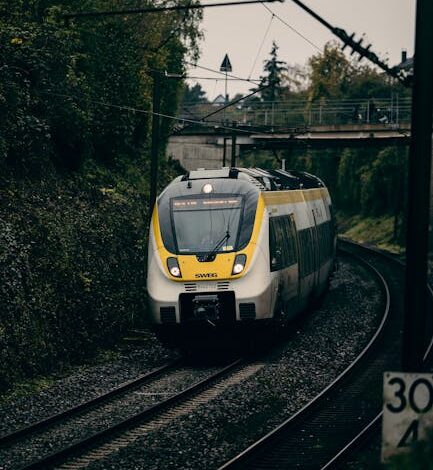The Rising Thermometer: Why Our Transit Systems Are Overheating

Remember that feeling? Stepping off a sweltering summer street and onto a train, only to find the carriage feels like a greenhouse on wheels? Or descending into the humid, stagnant air of a subway station, wondering if you’ll make it to your destination without melting? It’s not just a summer nuisance anymore; it’s becoming an increasingly common reality for millions of commuters worldwide. As global temperatures continue their relentless climb, the challenge of keeping our public transport networks cool, comfortable, and functional is morphing from a convenience into an absolute necessity.
Our subways and trains are the arteries of urban life, carrying us to work, school, and leisure. But these vital lifelines, especially those deep underground, were often designed for a cooler climate. The sheer volume of heat generated by trains, passengers, and mechanical systems, combined with external atmospheric warming, creates a formidable foe. There’s no single, magic bullet solution. Instead, tackling this pervasive problem requires a multi-pronged approach, blending innovative engineering with thoughtful urban planning. Let’s dive into how cities and transit authorities are confronting this scorching challenge.
The Rising Thermometer: Why Our Transit Systems Are Overheating
The core issue is straightforward: climate change is warming our world. But for transit, it’s a compounding problem. Underground tunnels, in particular, act like thermal batteries, absorbing heat from train brakes, electrical systems, and passenger body warmth, then radiating it back into the confined space. Above ground, trains bake under direct sunlight, while stations can become urban heat islands, trapping warmth that then seeps into adjacent platforms.
Compounding this is the age of much of our transit infrastructure. Many subway lines, like London’s Tube or New York’s MTA, date back over a century. Their original designs simply didn’t account for modern passenger volumes, more powerful (and heat-generating) trains, or the sustained high temperatures we now experience. Retrofitting these legacy systems presents enormous engineering and financial hurdles, making simple fixes often impossible.
Cooling the Rolling Stock: Innovations on the Tracks
One of the most immediate areas of focus is the trains themselves. Making the carriages cooler directly impacts passenger comfort, but it’s more complex than simply cranking up the AC.
Smarter HVAC Systems
Modern trains are being equipped with far more efficient and powerful Heating, Ventilation, and Air Conditioning (HVAC) systems. These aren’t just about blowing cold air; they’re designed to manage air circulation, humidity, and filtration more effectively. The trick, however, is balancing cooling capacity with energy consumption. Running powerful AC units draws significant electricity, which can strain power grids and increase operational costs, not to mention the carbon footprint if that energy isn’t from renewable sources. Engineers are exploring smarter sensors and AI-driven systems that can dynamically adjust cooling based on passenger load and external temperatures, optimizing both comfort and energy use.
Reflective Exteriors and Insulation
Just as a light-colored shirt helps you stay cooler in the sun, the exterior of a train can play a role. Painting train carriages with reflective, light-colored paints helps bounce away solar radiation, reducing the amount of heat absorbed into the train’s body. Some transit agencies are even experimenting with specialized thermal coatings that offer superior heat reflection. Inside, improved insulation in walls, roofs, and floors helps keep conditioned air in and external heat out, much like how your home’s insulation works to maintain a stable indoor temperature.
Passive Cooling Measures
Beyond active cooling, passive strategies are also being considered. Tinted or low-emissivity (low-e) windows can reduce solar gain without sacrificing visibility. Better aerodynamic designs can improve natural airflow around the train, and strategically placed vents within the carriages can aid in air circulation, even if it’s just to prevent pockets of stagnant, hot air.
Tackling the Tunnels and Stations: Infrastructure Solutions
While cooling the trains is crucial, it’s only half the battle. The environments in which they operate – the tunnels and stations – are often the primary source of the oppressive heat.
Ventilating the Underground
For subways, ventilation is paramount. Giant fans installed at various points along the tunnels and at station entrances work to extract hot air and draw in cooler air from outside. However, in a heatwave, the “cooler” outside air might still be uncomfortably warm. Newer systems are designed to create powerful air currents that literally push hot air out through dedicated ventilation shafts, often disguised as unassuming structures in urban landscapes. The sheer scale of air that needs to be moved in a vast underground network is astounding, requiring powerful, energy-intensive machinery.
Water-Based Cooling Systems
This is where some of the more innovative — and often complex — solutions come into play. The idea of cooling tunnels with water isn’t as far-fetched as it sounds. London’s Jubilee Line Extension, for instance, uses a system that draws cool groundwater from aquifers, circulates it through heat exchangers to cool station areas, and then returns the warmed water to another aquifer. This geothermal-like approach leverages natural temperature differences. Other concepts involve circulating chilled water through pipes embedded in tunnel walls or under platforms, essentially creating a massive, distributed cooling system. The challenges here are immense: infrastructure cost, potential for leaks, and the availability of suitable water sources that aren’t already stressed.
Smart Station Design and Materials
Above-ground stations can benefit significantly from smart architectural design. High ceilings, ample natural ventilation, and strategic use of shade structures or even green roofs can help reduce heat absorption and improve airflow. Materials used in construction matter too; lighter-colored, reflective materials for roofs and platforms can reduce radiant heat. On platforms, some cities are experimenting with misting systems or even air conditioning zones that provide localized relief, offering passengers a brief respite from the heat while they wait.
Beyond the Tech: Operational Strategies and The Long View
Ultimately, there’s no single technological silver bullet for keeping trains and subways cool in an ever-hotter world. It’s a complex dance between engineering, energy efficiency, and operational excellence.
Preventative maintenance of all cooling systems is non-negotiable. A failing AC unit or a blocked ventilation shaft can quickly turn a journey into an ordeal. Furthermore, integrating advanced climate modeling with transit operations can help predict heat hotspots and deploy resources proactively, perhaps by adjusting train schedules during peak heat or directing passengers to cooler routes.
Looking ahead, urban planning must increasingly consider transit infrastructure as part of the broader climate resilience strategy. This means investing in upgrades, designing new lines with climate change in mind, and exploring sustainable energy sources to power these cooling systems. The goal isn’t just to make our commutes bearable; it’s to ensure that public transport remains an attractive, viable, and sustainable option, encouraging people out of private cars and reducing overall emissions.
The challenge is significant, but the innovations emerging from cities worldwide offer a hopeful glimpse into a future where comfortable, efficient public transport can withstand the heat. It requires sustained investment, clever engineering, and a collective commitment to adapting our essential services to a changing climate, ensuring that our vital urban arteries continue to flow, no matter how high the mercury rises.





